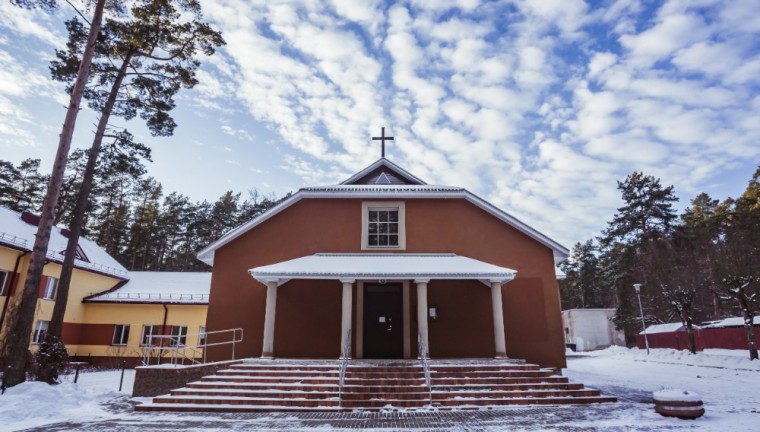Church of the Blessed Michael Sopoćko in Juodšiliai

119

1

0
5 out of 5
(1 reviews)
In Juodšiliai, a village located about 17 km south of the Lithuanian capital Vilnius, stands the church consecrated under the title of Blessed Michael Sopoćko. This is the first church in the world dedicated to this blessed individual.
Info
-

Religious Heritage
-
In Juodšiliai, a village located about 17 km south of the Lithuanian capital Vilnius, stands the church consecrated under the title of Blessed Michael Sopoćko. This is the first church in the world dedicated to this blessed individual.
Father Michael Sopoćko is one of the notable figures connected with Vilnius’s history, alongside saints and blessed figures such as St. Casimir, St. Andrew Bobola, St. Josaphat Kuntsevych, St. Raphael Kalinowski, Blessed George Matulaitis, and St. Faustina. He was a priest of the Archdiocese of Vilnius, a professor at the then Stephen Báthory University, an army chaplain, the confessor of Sister Maria Faustina Kowalska (canonized in 2000), and an untiring apostle of Divine Mercy.
The Juodšiliai church waited 80 years to be consecrated. The church construction, initiated by the Ursuline Sisters before World War II (1936), was halted due to the tense situation in Lithuania. The onset of war forced the cessation of construction, and the building was subsequently used as an orphanage, later a hospital, and a polyclinic. In 1991, a fire severely damaged the future church.
With the restoration of Lithuania’s independence, the idea of establishing a functioning church was revived. The faithful of Juodšiliai and the surrounding villages collected funds for construction, giving the building its intended purpose. Thus, 80 years after the Ursuline Sisters initiated the construction, the church was solemnly consecrated in 2016, during the Extraordinary Jubilee Year of Mercy declared by Pope Francis.
The choice of Juodšiliai for a church dedicated to Blessed Sopoćko is significant. During World War II, Father Michael Sopoćko, fleeing persecution by the occupying German authorities, hid in this village. Here, he found refuge and support from the Ursuline Sisters, continued his pastoral work, and prepared several scholarly works on Divine Mercy. Elderly residents of Juodšiliai still remember him as carpenter Vaclovas, who, while hiding under the name Vaclovas Rodzevičius, crafted useful wooden household items for neighbors. In 2012, a memorial plaque was unveiled on the house on Sodų Street, known as Providence, where he once hid.
In 2012, the city of Vilnius established a hospice named after Blessed Michael Sopoćko, providing free care for the terminally ill.
Michael Sopoćko
Born on November 1, 1888, into a noble and devout family in Naujasėdžiai (or Juševščizna) near Ashmyany, in the then Vilnius region (now Belarus). From an early age, Michael aspired to become a priest and dedicate his life to God's service. He graduated from the Vilnius Theological Seminary and later
studied pedagogy at the University of Warsaw, earning master's and doctoral degrees in theology.
Father Sopoćko’s most significant and fruitful years were spent in Vilnius. Here he received his education, was ordained, organized diocesan Catholic youth associations, and, after becoming a habilitated doctor, was appointed spiritual director of the Vilnius Theological Seminary and a lecturer at the Faculty of Theology at Stephen Báthory University. It was in Vilnius that he had his fateful meeting with Sister Faustina Kowalska.
His spiritual work was diverse. The special acquaintance with Sister Faustina and her visions inspired him to dedicate himself to spreading the message and cult of Divine Mercy. He sought to establish the Feast of Divine Mercy, was one of the founders of the Congregation of the Sisters of Merciful Jesus, and contributed to the painting of the famous image of the Merciful Jesus.
During the turbulent war years, from 1942 to 1944, he hid in Juodšiliai. After the Germans retreated, he moved to Vilnius, living in the rectory of St. John's Church. He taught at the seminary until it was closed in 1945, organized religious courses for nuns and laypeople, and even attempted to evangelize Russians arriving in Vilnius. Facing the threat of Soviet repression, he moved to Białystok in July 1947.
Father Sopoćko was also notable for his scholarly and pedagogical work. In 2008, following his beatification, several of his books were published, including "The Path of Love and Mercy," "In Your Mercy I Trust: Thoughts for Each Day," and "His Mercy Is Forever: Meditations on Divine Mercy." These texts present his thoughts, helping modern readers find the path of love and mercy.
Meeting with St. Faustina Kowalska
In 1933, Father Michael Sopoćko met Sister Faustina. At that time, he was the confessor for the Sisters of Our Lady of Mercy. Sister Faustina confided in him about her visions of the Merciful Savior and His commands: to establish the Feast of Mercy on the first Sunday after Easter, to found a new religious community, and to paint an image. These tasks, entrusted to her by the highest will, became the mission of Blessed Father Sopoćko’s life. He helped her understand the revelations, engaged in spreading the message of Divine Mercy, encouraged the painting of the Merciful Jesus image, printed the first Divine Mercy prayers, and advocated for the Church’s recognition of the Divine Mercy Feast and its cult.
Father Michael, listening to Sister Faustina’s long confessions, suggested she write down her spiritual experiences. This led to her "Diary," where anyone can now read about her visions.
Found a mistake?
Report

 Entertainment
Entertainment
 Food establishments
Food establishments





























 54.582757, 25.259715
54.582757, 25.259715
 Get directions
Get directions









